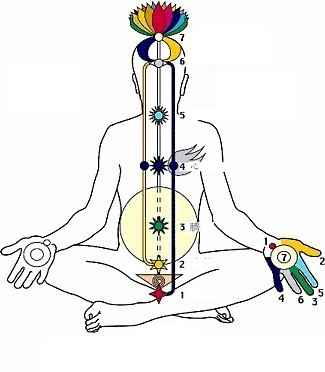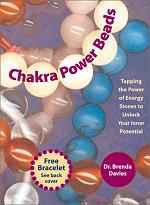rotten > Library > Religion > Chakras
Chakras
 The word chakra has reached that special semantic plateau reserved for terms like "soul," "evil," "God" or "401(k)."
The word chakra has reached that special semantic plateau reserved for terms like "soul," "evil," "God" or "401(k)."
You probably know people who like to pepper their conversations with these words. But when you ask them for a concrete definition of what the word means, they usually can't manage anything coherent.
Chakra meant "wheel" in ancient Sanskrit. As a religious concept, the term originated in the Vedas, the Hindu equivalent of the Old Testament.
The early Hindus believed the human soul was constructed of a cosmic energy called prana. This energy field was sometimes called the subtle body, or astral body, the metaphysical corollary to our gross human selves.
The subtle body existed on another plane from physical reality. In order to guide the physical body, prana had to reach across the planes and manifest itself here in our world. When prana interfaces with the human body, it creates a little spinning vortex—a chakra.
The chakras tend to be centered around certain areas of the body, but they are not considered "of the body." There are six major chakras on the normal human frame, with a seventh floating just above the head. (There are also minor chakras, including chakras that can occur in nature without being connected to a human body.)
Each of the seven major chakras is believed to have special qualities and colors. The details vary depending on whom you're talking to, but the general idea is as follows:
| | Location | Qualities | Color |
|---|
| Root Chakra |
Near the base of the spine, in between the genitals and the anus.
|
Survival, fight or flight. Base for generating energy through the body.
|
Red.
|
| Sacral Chakra |
Genitals, lower abdomen.
|
Sexual energy, sensuality, carnality.
|
Orange.
|
| Solar Plexus Chakra |
Solar plexus (just under the rib cage, near the navel).
|
Physical power (used in some martial arts). Willpower, decision-making.
|
Yellow.
|
| Heart Chakra |
Center of the sternum.
|
Emotions, love, nurturing.
|
Green.
|
| Throat Chakra |
Throat, just below the larynx.
|
Speech, communication.
|
Blue.
|
| Third Eye Chakra |
Center of the forehead.
|
Mind, imagination, visions.
|
Blue-Violet.
|
| Crown Chakra |
Floats over the top of the head.
|
Contact with the divine, ascension, evolution.
|
Violet, ultraviolet.
|
Despite a great deal of scientific research, no one has ever found any real biological foundation to support the existence of chakras. The chakra points roughly correspond to bundles of nerves that extend from the spinal cord, but those bundles don't seem to serve any special function (beyond the normal nervous system controls).
 Once you get past these basic points, consensus thinking begins to deteriorate into "anything goes." Even within Hinduism and Buddhism, the two major religions which feature chakras prominently, there are any number of possible definitions for what, exactly, a chakra is supposed to be. In some texts, they're described as energy centers; in later texts they are characterized as an accumulation of consciousness.
Once you get past these basic points, consensus thinking begins to deteriorate into "anything goes." Even within Hinduism and Buddhism, the two major religions which feature chakras prominently, there are any number of possible definitions for what, exactly, a chakra is supposed to be. In some texts, they're described as energy centers; in later texts they are characterized as an accumulation of consciousness.
 They are sometimes considered doors to put spiritual energy into the body, or valves to let that energy out. Chakras are an important part of various yoga and meditation practices, and they are used in some forms of magic. Reiki healing is centered on the chakras, and many practitioners of acupuncture use the chakras in combination with other subtle energy points on the body.
They are sometimes considered doors to put spiritual energy into the body, or valves to let that energy out. Chakras are an important part of various yoga and meditation practices, and they are used in some forms of magic. Reiki healing is centered on the chakras, and many practitioners of acupuncture use the chakras in combination with other subtle energy points on the body.
The concept of subtle energy, sometimes called the refined energy, is extremely metaphysical. It's not exactly a soul. The chakras themselves are supposed to be located on the subtle body, rather than the physical body, but the primary way to interact with them is through the physical body.
While refined energy is nothing like physical energy (light, heat, radiation, etc.), recent scientific studies suggest that there may be some sort of physical phenomenon associated with the chakras and acupuntcture points. A German research project found that the electrical resistance of the skin was connected to the stimulation of acupuncture points, which include the chakras. However, the study didn't indicate that the chakras tested differently from the other points.
 The notion of chakras as centers of consciousness is a little more compelling than simply calling them an "energy nexus," which is largely meaningless in context. It's probably not coincidental that the chakras correspond to physical locations where people commonly describe holding sensations or emotions, such as a "broken heart," a "gut instinct" or words that "catch in your throat." As an added bonus, there is currently no way to scientifically measure consciousness, which makes it difficult to prove this thesis wrong.
The notion of chakras as centers of consciousness is a little more compelling than simply calling them an "energy nexus," which is largely meaningless in context. It's probably not coincidental that the chakras correspond to physical locations where people commonly describe holding sensations or emotions, such as a "broken heart," a "gut instinct" or words that "catch in your throat." As an added bonus, there is currently no way to scientifically measure consciousness, which makes it difficult to prove this thesis wrong.
All this ambiguity and loose terminology has had predictable side effects. For instance, a recent search on Amazon.com coughed up almost 4,500 books on chakras, and that's just books. With very little effort, the undiscriminating shopper can find and buy chakra candles, chakra spell kits, chakra incense, chakra music, chakra greeting cards, chakra tea, chakra perfumes, chakra-tuning herbs, chakra stones, chakra bracelets, and chakra chimes, among others.
 You can stick the word "chakra" on just about any prepackaged New Age product and add a markup of at least 20%. Are you peddling a love potion? Why not make it a Chakra Love Potion? Selling an occult talisman? You can charge more if it's a chakra talisman! The Rotten Library? Why not the Chakra Rotten Library? (OK, now you're just being ridiculous.)
You can stick the word "chakra" on just about any prepackaged New Age product and add a markup of at least 20%. Are you peddling a love potion? Why not make it a Chakra Love Potion? Selling an occult talisman? You can charge more if it's a chakra talisman! The Rotten Library? Why not the Chakra Rotten Library? (OK, now you're just being ridiculous.)

Pornopolis |
Rotten |
Faces of Death |
Famous Nudes
|
 The word chakra has reached that special semantic plateau reserved for terms like "soul," "evil," "God" or "401(k)."
The word chakra has reached that special semantic plateau reserved for terms like "soul," "evil," "God" or "401(k)."  They are sometimes considered doors to put spiritual energy into the body, or valves to let that energy out. Chakras are an important part of various yoga and meditation practices, and they are used in some forms of
They are sometimes considered doors to put spiritual energy into the body, or valves to let that energy out. Chakras are an important part of various yoga and meditation practices, and they are used in some forms of  The notion of chakras as centers of consciousness is a little more compelling than simply calling them an "energy nexus," which is largely meaningless in context. It's probably not coincidental that the chakras correspond to physical locations where people commonly describe holding sensations or emotions, such as a "broken heart," a "gut instinct" or words that "catch in your throat." As an added bonus, there is currently no way to scientifically measure consciousness, which makes it difficult to prove this thesis wrong.
The notion of chakras as centers of consciousness is a little more compelling than simply calling them an "energy nexus," which is largely meaningless in context. It's probably not coincidental that the chakras correspond to physical locations where people commonly describe holding sensations or emotions, such as a "broken heart," a "gut instinct" or words that "catch in your throat." As an added bonus, there is currently no way to scientifically measure consciousness, which makes it difficult to prove this thesis wrong.  You can stick the word "chakra" on just about any prepackaged New Age product and add a markup of at least 20%. Are you peddling a love potion? Why not make it a Chakra Love Potion? Selling an occult
You can stick the word "chakra" on just about any prepackaged New Age product and add a markup of at least 20%. Are you peddling a love potion? Why not make it a Chakra Love Potion? Selling an occult 